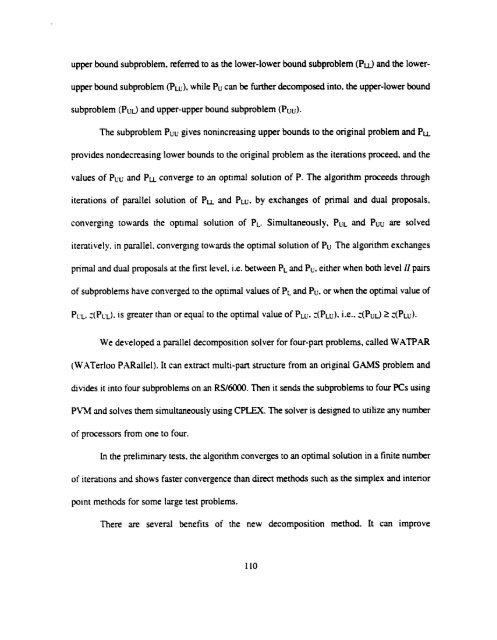X - UWSpace - University of Waterloo
X - UWSpace - University of Waterloo
X - UWSpace - University of Waterloo
Create successful ePaper yourself
Turn your PDF publications into a flip-book with our unique Google optimized e-Paper software.
upper bound subpmblem, refemd to as the lower-lower bound subproblem (Pd and the lower-<br />
upper bound subproblem (Pw), while Pu cm be further decornposed into. the upper-lower bound<br />
subproblem (Pv3 and upper-upper bound subproblem (Puu).<br />
The subproblem Puu gives nonincreasing upper bounds to the original problem and PL<br />
provides nondecreving lower bounds to the original problem as the itentions proceed and the<br />
values <strong>of</strong> Puu and PL converge to an optimal solution <strong>of</strong> P. The algorithm proceeds through<br />
itentions <strong>of</strong> parailei solution <strong>of</strong> Pu and PLU. by exchanges <strong>of</strong> primal and dud proposais.<br />
converging towûrds the optimal solution <strong>of</strong> PL. Simuitmeously. PuL and Pvu are solved<br />
itentively. in pdlel. converpng towxds the optimal solution <strong>of</strong> Pu The algorithm exchanges<br />
primal and dual propos& rt the first level. i.e. between PL and Pu, either when both level II pain<br />
<strong>of</strong> subproblems have converged to the optimd values <strong>of</strong> PL and Pu, or when the optimal value <strong>of</strong><br />
PCL, :(PC3. is pater than or equal to the optimal value <strong>of</strong> PLU. :(PLU). Le.. :(Pu3 2 :(PLU).<br />
We developed a paralle1 decomposition solver for four-part problems, called WrZTPAR<br />
(WATerloo PARallel). It cm extnct multi-pan structure from an original GAIS problem and<br />
divides it into four subproblems on an RSi6000. Then it sends the subproblems to four PCs using<br />
P W and solves hem simuitmeously using CPLEX. The solver is designed to utilize any number<br />
<strong>of</strong> processon from one to four.<br />
In the preliminq tests. the algorithm converges to an optimal solution in a finite number<br />
<strong>of</strong> itentions and shows faster convergence than direct methods such as the simplex and interior<br />
point methods for some large test problems.<br />
There are seved benefits <strong>of</strong> the new decomposiuon method. It cm impmve
















